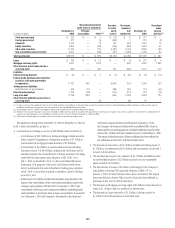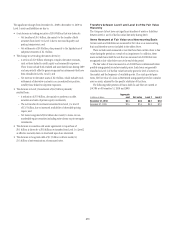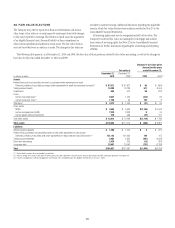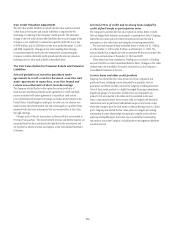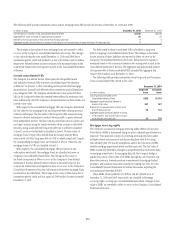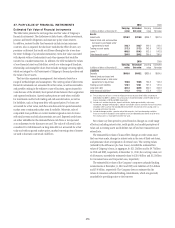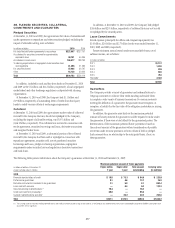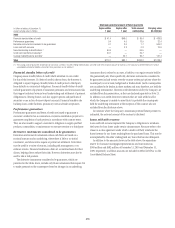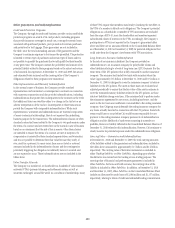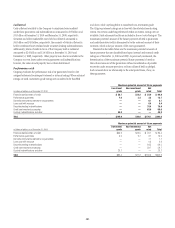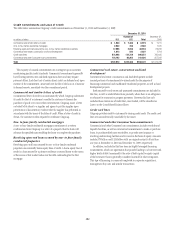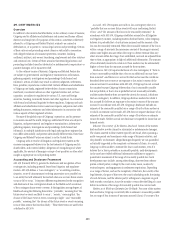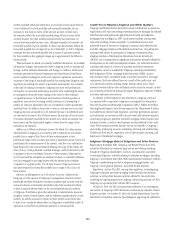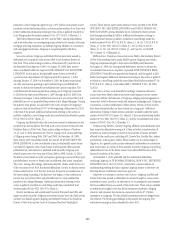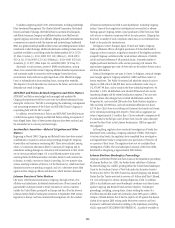Citibank 2010 Annual Report Download - page 281
Download and view the complete annual report
Please find page 281 of the 2010 Citibank annual report below. You can navigate through the pages in the report by either clicking on the pages listed below, or by using the keyword search tool below to find specific information within the annual report.279
The repurchase reserve estimation process is subject to numerous
estimates and judgments. The assumptions used to calculate the repurchase
reserve contain a level of uncertainty and risk that, if different from actual
results, could have a material impact on the reserve amounts. The key
assumptions are:
• loan documentation requests;
• repurchase claims as a percentage of loan documentation requests;
• claims appeal success rate; and
• estimated loss given repurchase or make-whole.
For example, Citi estimates that if there were a simultaneous 10% adverse
change in each of the significant assumptions, the repurchase reserve would
increase by approximately $342 million as of December 31, 2010. This
potential change is hypothetical and intended to indicate the sensitivity of
the repurchase reserve to changes in the key assumptions. Actual changes in
the key assumptions may not occur at the same time or to the same degree
(i.e., an adverse change in one assumption may be offset by an improvement
in another). Citi does not believe it has sufficient information to estimate a
range of reasonably possible loss (as defined under ASC 450) relating to its
Consumer representations and warranties.
Securities lending indemnifications
Owners of securities frequently lend those securities for a fee to other parties
who may sell them short or deliver them to another party to satisfy some
other obligation. Banks may administer such securities lending programs for
their clients. Securities lending indemnifications are issued by the bank to
guarantee that a securities lending customer will be made whole in the event
that the security borrower does not return the security subject to the lending
agreement and collateral held is insufficient to cover the market value of
the security.
Credit card merchant processing
Credit card merchant processing guarantees represent the Company’s indirect
obligations in connection with the processing of private label and bankcard
transactions on behalf of merchants.
Citigroup’s primary credit card business is the issuance of credit cards to
individuals. In addition, the Company: (a) provides transaction processing
services to various merchants with respect to its private-label cards and
(b) has potential liability for transaction processing services provided by a
third-party related to previously transferred merchant credit card processing
contracts. The nature of the liability in either case arises as a result of a
billing dispute between a merchant and a cardholder that is ultimately
resolved in the cardholder‘s favor. The merchant is liable to refund the
amount to the cardholder. In general, if the credit card processing company
is unable to collect this amount from the merchant the credit card processing
company bears the loss for the amount of the credit or refund paid to
the cardholder.
With regard to (a) above, the Company continues to have the primary
contingent liability with respect to its portfolio of private-label merchants.
The risk of loss is mitigated as the cash flows between the Company and the
merchant are settled on a net basis and the Company has the right to offset
any payments with cash flows otherwise due to the merchant. To further
mitigate this risk the Company may delay settlement, require a merchant
to make an escrow deposit, include event triggers to provide the Company
with more financial and operational control in the event of the financial
deterioration of the merchant, or require various credit enhancements
(including letters of credit and bank guarantees). In the unlikely event that
a private-label merchant is unable to deliver products, services or a refund to
its private-label cardholders, the Company is contingently liable to credit or
refund cardholders.
With regard to (b) above, the Company has a potential liability for
bankcard transactions with merchants whose contracts were previously
transferred by the Company to a third-party credit card processor, should that
processor fail to perform.
The Company’s maximum potential contingent liability related to both
bankcard and private-label merchant processing services is estimated to be
the total volume of credit card transactions that meet the requirements to be
valid chargeback transactions at any given time. At December 31, 2010 and
December 31, 2009, this maximum potential exposure was estimated to be
$65 billion and $60 billion, respectively.
However, the Company believes that the maximum exposure is not
representative of the actual potential loss exposure based on the Company’s
historical experience and its position as a secondary guarantor (in the case
of previously transferred merchant credit card processing contracts). In
both cases, this contingent liability is unlikely to arise, as most products
and services are delivered when purchased and amounts are refunded when
items are returned to merchants. The Company assesses the probability and
amount of its contingent liability related to merchant processing based on
the financial strength of the primary guarantor, the extent and nature of
unresolved charge-backs and its historical loss experience. At December 31,
2010 and December 31, 2009, the estimated losses incurred and the carrying
amounts of the Company’s contingent obligations related to merchant
processing activities were immaterial.
Custody indemnifications
Custody indemnifications are issued to guarantee that custody clients will
be made whole in the event that a third-party subcustodian or depository
institution fails to safeguard clients’ assets.
Other
As of December 31, 2010, Citigroup carried a reserve of $254 million
related to certain of Visa USA’s and MasterCard’s litigation matters. As of
December 31, 2009, the carrying value of the reserve was $121 million and
was included in Other liabilities on the Consolidated Balance Sheet.


